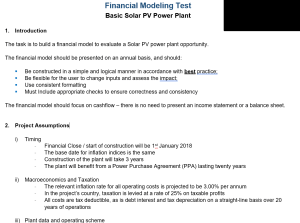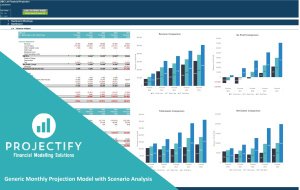
Finance Model Templates 10 comments

What are Financial Model Templates?
A Financial Model Template is the summary of a company’s performance, based on certain variables, which calculates the future performance of a business. This type of forecast is established on the company’s historical performance and makes predictions about the future. Financial Model Templates require preparing an income statement, balance sheet, cashflow statement, and supporting schedules (also known as a 3-statement model). Once completed, more sophisticated types of models can be built such as discounted cash flow analysis (DCF Model), leveraged buyout (LBO), mergers and acquisitions (M&A), and sensitivity analysis.
What are Financial Model Templates used for?
Financial Model Templates are used for decision making and performing financial analysis. Within companies, executive use financial models to make decisions about the following: 1. Raising capital, debt, or equity 2. Acquiring businesses or assets 3. Expanding the business organically 4. Selling or divesting assets and business units 5. Budgeting and forecasting 6. Capital allocation 7. Valuing a business 8. Financial statement (ratio) analysis 9. Management accounting
Why is using a Financial Model Template beneficial?
Using a Financial Model Template is quick, easy, and gives you your desired results. Building a Financial Model from scratch can be overwhelming, especially when you don’t know where to begin. Instead, using a template is an attractive option because it requires a much lower initial investment of time and money rather than it would to build your own model.
The Most Common Types of Financial Models
1. The Three Statement Financial Model
This is the simplest form of financial modeling and is comprised of three different kinds of financial statements: the income statement, balance sheet and cash flow statement, all of which use dynamic formulas within Excel. The key idea behind the Three Statement Financial Model is that all three will be interconnected, and the input assumptions can prompt changes within the entire model. A sound basis of core finance, accounting and Excel skills are fundamental to linking these statements together.
2. DCF (Discounted Cash Flow) Model
The DCF model takes the Three Statement Financial Model further in order to estimate a company’s value. This is done using the NPV (Net Present Value) of a business’ future cash flow.
Slight alterations are made to the Cash Flow Statement from the Three Statement Financial Model before the XNPV function in Excel is applied, discounting them back to the company’s present day WACC (Weighted Average Cost of Capital). Financial models of this kind are primarily used in capital markets and equity research.
3. M&A Models
These are more technical forms of financial models whose aim is to analyse the finances of both mergers and acquisitions, focussing on evaluating its pro forma accretion or dilution. Each of the companies is often represented within a single tab to fit with the idea that Company 1 + Company 2 = Merged company. This kind of model is commonly used in investment banking and corporate development with varying levels of complexity.
4. IPO (Initial Public Offering) Models
IPO models are often built by investment bankers and corporate development professionals before a business goes public in order to estimate its value. These models are based on assumptions of how much investors would be ready to pay for a given company. Within the model, the valuation also includes what is known as an “IPO discount” which is designed to make sure that stocks trade well on the secondary market.
5. LBO (Leveraged Buyout Model)
This is another form of advanced financial modeling which focusses on modeling complex debt schedules. These models are often some of the most difficult and detailed models to create with many intricate layers and circular references as well as the cash flow waterfalls. These models are again most common in private equity and investment banking.
6. Sum of the Parts Models
These models are created by combining numerous different DCF models. Once these have been added together, different elements of a business that may not have been suitable for DCF analysis are then added to the business’ value. As such, this model is a sum of the different elements of a business, its investments and liabilities in order to arrive at the Net Asset Value for the business.
7. Consolidation Models
These models are a combination of various business units within one single model. Each of these business units is typically represented within a single tab. These tabs are then culminated within a consolidation tab which acts as a sum of all the different business units. These models are often similar to the Sum of the Parts models.
8. Budget Model
These kinds of financial models are frequently used by professionals in FP&A (Financial Planning & Analysis) in order to establish a business’ budget for the next year or years. Much of the budget model is heavily based on the information within the business’ income statement and is typically designed to display monthly or quarterly figures.
9. Forecasting Model
Again, these models are often used in FP&A as a means of building forecast estimations that can then be used in comparison and conjunction with the budget model. Budget models and forecasting models are sometimes seen within the same workbook but can also be completely separated from one another.
10. Option Pricing Model
These models are frequently found in two forms: binominal tree models and Black-Scholes models. They are a fairly uncomplicated calculators within Excel as they are based solely on mathematical models.
To find out more about Financial model templates
Business Model vs. Financial Model
Benefits of Financial Modeling Course
What is Finance?
Finance can be defined as the term describing two major intertwined activities:
- the management of money as an asset
- the process of finding necessary funds for projects
Funding is key for all major stakeholders in an economy: individuals, corporations and governments. This is what explains the classical division of the discipline into:
- Personal Finance
- Corporate Finance
- Public Finance
Major activities in Finance, for all of the three categories above include: investing in value-added projects, obtaining the cheapest credit possible, the allocation of funds to back up liabilities and making these operations happen (ie: banking).
More on finance on Investopedia here
Why is Finance key for organizations?
Successful Finance Management is one of the key pillars for a healthy organization. The discipline uses a number of financial instruments (eg: loans, investments, securities) to answer an organization’s financial needs. Good financial management and funding helps organizations fund the assets necessary for their growth (i.e: labor, machinery, equipment, services etc.). Keeping an eye on key financial indicators and using the right financial instruments, tools and strategies is at the heart of an organizations life, survival and expansion. Finance functions can either be in-house, outsourced, used on a temporary basis (Consulting) or, most often, a combination of the three.
How can you get a job in Finance?
Landing a Finance job isn’t easy, as having and using with success the right knowledge is a pre-requisite.
Possible paths to land a job in Finance are:
- o Getting an MBA, Bachelors or Master Degree in Finance
- o Statutory Courses validated by official authorities
- o Chartered Accountants
- o Cost & Management Accountants
- o Specialized Finance Courses
- o CFA (Chartered Financial Analyst)
- o CFP (Chartered Financial Planner)
- o Economics Courses
- o Statistics Courses
- o CAIA (Chartered Alternate Investment Analyst)
- o Financial Risk Manager
- o Financial Modeling and Investment Banking Programs (Offline or Online)
More on getting a Job in Finance on Quora here
How can I acquire the skills and tools used in Finance?
Most Finance professionals, on top of their knowledge, have a set of tools they use for their daily or exceptional operations. They either build them themselves from scratch based on their expertise and experience of a large or specific sector or they use ready-made tools provided by their firm, colleagues or online web-sites.
Eloquens is in this last category, as an intermediary between financial tool authors and financial tool users, with the objective of helping finance professionals building on each other’s work instead of having to reinvent the wheel every time. You will find below, for download and open discussion a number of excel financial models and methodologies by world-class academics, experts and professionals.
To find out more about Finance in general
Most popular Model Templates
 Five Different Modeling Exams with 1 Solution5,2421add_shopping_cart$30.00
Five Different Modeling Exams with 1 Solution5,2421add_shopping_cart$30.00 by Bassem Mneimné
by Bassem Mneimné

Solar Farm Development Excel Model Template
Complete financial model for financing, building, operating, and selling solar farms.12,26112add_shopping_cart$35.00 by DW Financial Services
by DW Financial Services

Blockchain/ICO Forecasting and Analysis Financial Excel Model Template
This ICO model allows you to analyse and create financial projections for cryptocurrencies and blockchains.4,7856add_shopping_cart$99.00 by Alex Martyanov
by Alex Martyanov

Customizable Carried Interest Waterfall Excel Template
Customizable and powerful template for carried interest calculations for private equity projects8,0583add_shopping_cart$49.00 by Alex Martyanov
by Alex Martyanov

Generic Monthly 5-Year 3 Statement Rolling Financial Projection Model with Scenario Analysis
User-friendly 3 statement 5 year generic rolling financial projection Excel model with scenario analysis2,8822add_shopping_cart$60.00 by Projectify
by Projectify

Real Estate Multi Family Development Excel Model
The real estate model provides a comprehensive tool for evaluating multi-family property investments with dynamic cash flow analysis and flexible financing.4,3297add_shopping_cart$60.00 by Jair Almeida
by Jair Almeida








